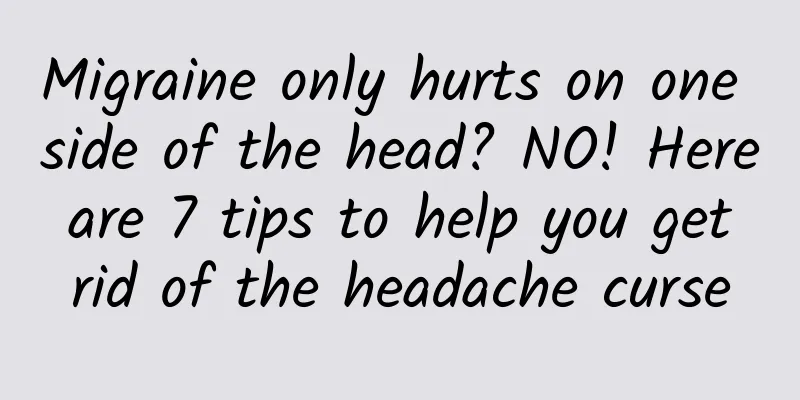Migraine only hurts on one side of the head? NO! Here are 7 tips to help you get rid of the headache curse

|
There is a kind of pain that makes people unforgettable, called migraine. Who can understand the pain of migraine? Probably only those who have experienced it know how torturous it is to a person. Whether it is a 1.8-meter-tall man or a little girl in school, when an attack occurs, people want to hit their heads, and sometimes the pain is so severe that they can't help crying out loud. But then it would suddenly disappear, as if it had never been there, and this torment might continue intermittently for many years... Xiaoyu (pseudonym), 26 years old, is an urban white-collar worker who has been suffering from migraines. I have had headaches since childhood. The wind blows and I get unbearable headaches. I also get a dull headache when I smell a bad odor. I also get headaches after studying or working for a long time. Headaches are more likely to be triggered during the menstrual period, and when the headache is severe, I also experience nausea and vomiting. Recently, Xiaoyu found that her headache attacks were becoming more and more frequent, which had a certain impact on her life and work, so she went to the hospital for treatment. No obvious abnormalities were found in the transcranial brain CT examination, the EEG examination was normal, and the complete blister test was negative. Combined with the patient's medical history and characteristics of the attack, it was clearly diagnosed as migraine, and the Western medical name for the disease is vascular neurotic headache. After a clear diagnosis, the doctor gave her a combination of Chinese and Western medicine treatment. After standardized medication, Xiaoyu's condition stabilized and her headache symptoms were relieved. Doctors remind that migraine, also known as vascular neurosis headache, is one of the common primary headaches in clinical practice. It is more common in women and is often related to genetic factors as well as endocrine and metabolic factors. It is prone to occur during menstruation or before menstruation. If the disease recurs, it should be taken seriously and active drug treatment can improve the symptoms. Migraine is the most common type of primary headache in clinical practice and the third most common disease in the world. It has a very high incidence rate and is extremely painful when it occurs. After the remission period, the symptoms are exactly the same as those of normal people. The symptoms vary from person to person during an attack and may recur with varying frequency. The main clinical manifestation is paroxysmal moderate to severe, throbbing headaches, which are mostly unilateral and generally last for 4 to 72 hours, and may be accompanied by nausea, vomiting, etc. Light, sound stimulation or daily activities can aggravate headaches, and a quiet environment and rest can relieve headaches. Migraine is also a chronic neurovascular disease. It often occurs in childhood and adolescence, reaches a peak incidence in middle-aged and young people, is more common in women, has a prevalence of 5% to 10% in the population, and often has a genetic background. According to statistics from the World Health Organization (WHO), there are approximately 1.3 billion migraine sufferers worldwide, and the number of female patients is three times that of male patients. What causes migraines? 1. Internal factors 1. Genetic factors Migraine is a genetic susceptibility, and about 60% of migraine patients have a family history. If a person suffers from migraine, the risk of his relatives developing migraine is 3 to 6 times that of the general population. 2. Metabolic and endocrine factors It occurs more frequently in women than in men, and attacks are more likely to occur during puberty or menstruation, while attacks decrease or cease during pregnancy or after menopause. 3. Disorders of nerve cell excitability Some scholars believe that migraine is caused by the inhibition of cerebral cortical expansion, which causes constriction of blood vessels distributed in the cortex, resulting in visual, movement, sensation and speech disorders, and subsequently causing throbbing headaches. 2. External factors Fatigue, staying up late, catching a cold, catching a cold or not getting enough rest, eating spicy or irritating foods, caffeine, strong tea, etc. can also trigger headaches. Where exactly does a migraine hurt? Many people believe that migraine is a unilateral headache, but in fact, nearly 40% of patients experience pain on both sides. Migraine does not have a fixed pain location. It may hurt in one temple, or in both temples, or in the top of the forehead, or in the back of the neck... The pain location is very capricious and can change at any time. It may hurt in the temple this time, and in the forehead next time. There are many different types of migraines, but the most common types include: 01 Common migraine Common migraine is the most common type of migraine, also known as migraine without aura, accounting for about 80% and is common in women during adolescence. Without treatment or with ineffective treatment, each headache lasts for 4 to 72 hours, mainly manifested as a throbbing headache on one side, accompanied by symptoms such as nausea, vomiting, sweating, photophobia, etc. Strong emotional fluctuations and physical activity will aggravate the headache. The first-degree relatives of this type of migraine patients have a 1.9-fold higher risk of asymptomatic migraine and a 1.4-fold higher risk of migraine with aura than the general population. The genetic sites detected suggest that increased extracellular glutamate concentrations are related to the onset of migraine. 02 Typical migraine Typical migraine, also known as aura headache, accounts for about 10% and often has a family history. It is usually a dull pain, which may have a throbbing feeling and gradually increases in severity. After reaching its peak, it may last for several hours or 1 to 2 days. The clinical characteristics are visual precursor symptoms before the headache, such as flashing dark spots in front of the eyes, which may gradually expand to form hemianopsia. It usually starts with throbbing pain in one side of the forehead, which can often extend to the entire half of the head or the entire head, often accompanied by photophobia, phonophobia, pallor, nausea, vomiting, abdominal pain and other symptoms. The pain is made worse by bright light, sound, walking, or physical activity, and it eases or goes away with rest or sleep. 03 Migraine in children The attacks are not as typical as those in adults, and the gastrointestinal symptoms are very prominent, mainly manifested as: the duration of headache attacks is relatively short, but the attacks are relatively frequent; the pulsating characteristics of the headache are not prominent; unilateral headaches are less common, but bilateral frontal and temporal pain is more common; gastrointestinal symptoms are prominent, and vomiting and abdominal pain may occur; prodromal symptoms are rare. In addition to the above three types, there are some special types of migraine, mainly hemiplegic migraine (clinically rare, hemiplegia may be a precursor to migraine), basilar migraine (more common in children and adolescent women), and ophthalmoplegic migraine (ophthalmoplegia occurs on the side of the headache during a migraine attack or when the headache subsides after an attack). How to get rid of the headache "curse"? 1 Cold compress You can apply ice packs to your temples to lower the temperature of the blood in your head, which can effectively relieve headaches. You can also apply a wet towel to your head for about 20 minutes to provide relief. In addition, you can also place an ice pack near your forehead or neck to relieve pain through local cold compress cooling. 2 Acupressure Put the index fingers and middle fingers of both hands together to massage the temples, press the Baihui point on the top of the head with the middle fingers, and massage the Fengchi point behind the lower back of the ear with the thumbs. Do this for 2 minutes, which can significantly relieve headaches. 3 Hot water hand soak Soak your hands in warm water for half an hour. This will dilate the blood vessels in your hands, reduce blood flow to the brain, and relieve headaches. 4 Towel wrapped head When you feel pain, use a towel or soft cloth to wrap it around your temples appropriately. This can effectively inhibit blood vessel dilation and relieve headaches. 5 Drug treatment Nonsteroidal anti-inflammatory drugs such as ibuprofen and naproxen can be taken orally, but patients with gastrointestinal diseases must use them with caution because these drugs have certain side effects of gastric mucosal irritation. Please use them under the guidance of a doctor. 6 Diet therapy For example, drink mint tea or green tea to relieve headaches, but be careful to avoid foods such as red wine, coffee, and chocolate. 7 Other methods Keeping the environment quiet, avoiding strong sunlight and light stimulation, reducing tension, etc., can also help relieve headaches. Symptoms can also be relieved through appropriate physical exercise such as brisk walking, jogging, and listening to music to relax. Kind tips Migraine patients should pay attention to the following in their daily lives:
-END- Source of this article: pexels (delete for infringement) |
<<: Will having a fat belly make you stupid? Do these 6 things to effectively reduce belly fat!
>>: How to monitor a typhoon that “runs” throughout its life?
Recommend
Kuaishou Operation: Inventory of techniques to increase followers!
How to operate Kuaishou and increase followers qu...
Rabbit Year: Rabbit Zun from the Western Zhou Dynasty, Rabbit Paintings from Dunhuang, Jade Rabbits from the Ming Dynasty... Good Meanings Since Ancient Times
Good luck rabbit Rabbit in Chinese Culture It has...
Top 10 milestones of artificial intelligence in 2016: revolution or bubble?
It is a new year again, and 2016 has ended in turm...
What? This animal can actually understand "stop at red lights and go at green lights"?
In our cities, there are actually many wild anima...
What? I've been picking pine cones for so many years, and you tell me it's not a fruit?
There is a "pine cone tower" hanging ne...
Google Chrome Remote Desktop is now available on iOS
After launching on Android platform in April last...
Wu Xiaobo: 18 Rules for We-Media Marketing
On November 1, Daxiang Media invited Teacher Wu t...
2017 Baidu Alliance Summit: Robin Li proposed new thinking in the AI era
The "new generation of technological revolut...
Labor Day brand promotion strategy!
The May Day holiday is approaching, and major bra...
After living on land for a long time, can you return to the ocean to live a "carefree" life?
Produced by: Science Popularization China Author:...
If iPhone X and Huawei Mate10 have the same price, which one would you choose?
The Apple iPhone X, which is about to be official...
[Smart Farmers] Why did this plant make ancient poets feel mixed emotions? Uncover the secrets behind the "darling of poetry"
Your browser does not support the video tag In an...
What’s the matter with Ctrip’s plan to delist? What is the market value of Ctrip?
Ctrip plans to delist According to foreign media ...
Pinching, dripping glue, slime...are popular handmade toys also poisonous?
Review expert: Zhou Hongzhi, senior laboratory te...









